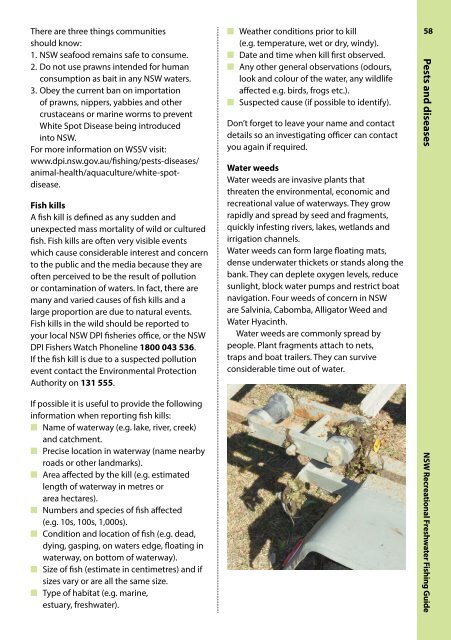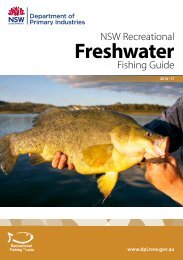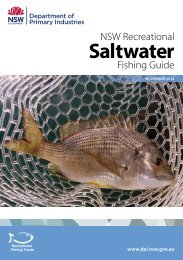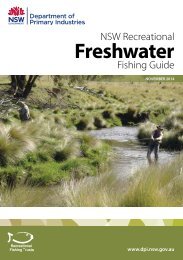freshwater-recreational-fishing-guide-2018-19
Create successful ePaper yourself
Turn your PDF publications into a flip-book with our unique Google optimized e-Paper software.
There are three things communities<br />
should know:<br />
1. NSW seafood remains safe to consume.<br />
2. Do not use prawns intended for human<br />
consumption as bait in any NSW waters.<br />
3. Obey the current ban on importation<br />
of prawns, nippers, yabbies and other<br />
crustaceans or marine worms to prevent<br />
White Spot Disease being introduced<br />
into NSW.<br />
For more information on WSSV visit:<br />
www.dpi.nsw.gov.au/<strong>fishing</strong>/pests-diseases/<br />
animal-health/aquaculture/white-spotdisease.<br />
Fish kills<br />
A fish kill is defined as any sudden and<br />
unexpected mass mortality of wild or cultured<br />
fish. Fish kills are often very visible events<br />
which cause considerable interest and concern<br />
to the public and the media because they are<br />
often perceived to be the result of pollution<br />
or contamination of waters. In fact, there are<br />
many and varied causes of fish kills and a<br />
large proportion are due to natural events.<br />
Fish kills in the wild should be reported to<br />
your local NSW DPI fisheries office, or the NSW<br />
DPI Fishers Watch Phoneline 1800 043 536.<br />
If the fish kill is due to a suspected pollution<br />
event contact the Environmental Protection<br />
Authority on 131 555.<br />
If possible it is useful to provide the following<br />
information when reporting fish kills:<br />
■■<br />
Name of waterway (e.g. lake, river, creek)<br />
and catchment.<br />
■■<br />
Precise location in waterway (name nearby<br />
roads or other landmarks).<br />
■■<br />
Area affected by the kill (e.g. estimated<br />
length of waterway in metres or<br />
area hectares).<br />
■■<br />
Numbers and species of fish affected<br />
(e.g. 10s, 100s, 1,000s).<br />
■■<br />
Condition and location of fish (e.g. dead,<br />
dying, gasping, on waters edge, floating in<br />
waterway, on bottom of waterway).<br />
■■<br />
Size of fish (estimate in centimetres) and if<br />
sizes vary or are all the same size.<br />
■■<br />
Type of habitat (e.g. marine,<br />
estuary, <strong>freshwater</strong>).<br />
■■<br />
Weather conditions prior to kill<br />
(e.g. temperature, wet or dry, windy).<br />
■■<br />
Date and time when kill first observed.<br />
■■<br />
Any other general observations (odours,<br />
look and colour of the water, any wildlife<br />
affected e.g. birds, frogs etc.).<br />
■■<br />
Suspected cause (if possible to identify).<br />
Don’t forget to leave your name and contact<br />
details so an investigating officer can contact<br />
you again if required.<br />
Water weeds<br />
Water weeds are invasive plants that<br />
threaten the environmental, economic and<br />
<strong>recreational</strong> value of waterways. They grow<br />
rapidly and spread by seed and fragments,<br />
quickly infesting rivers, lakes, wetlands and<br />
irrigation channels.<br />
Water weeds can form large floating mats,<br />
dense underwater thickets or stands along the<br />
bank. They can deplete oxygen levels, reduce<br />
sunlight, block water pumps and restrict boat<br />
navigation. Four weeds of concern in NSW<br />
are Salvinia, Cabomba, Alligator Weed and<br />
Water Hyacinth.<br />
Water weeds are commonly spread by<br />
people. Plant fragments attach to nets,<br />
traps and boat trailers. They can survive<br />
considerable time out of water.<br />
58<br />
Pests and diseases<br />
NSW Recreational Freshwater Fishing Guide








